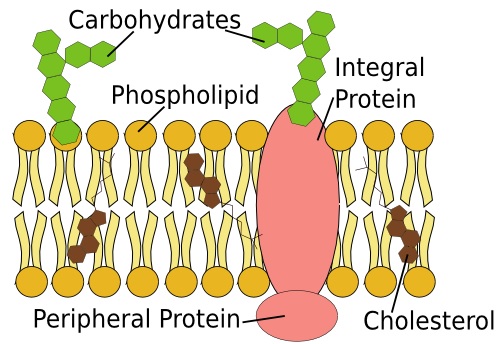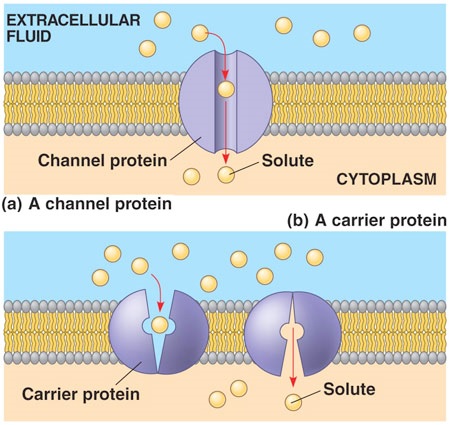Structure and function of cell membranes Assignment Help
It is a well known fact that cell is an integral part of any living body. But the structure and function of the cells are not alone controlled by the organelles present within it; rather it depends upon the membranes as well. Therefore, cell membranes are the part of any cell that divide the interior of the cell with the exterior and also define compartment of different cell organelles.
Structure of cell membranes:
 All the cell membranes have a common structure that includes phospholipids bilayer along with the involvement of particular proteins that carries on different functions. Image reference: www.imgarcade.com
All the cell membranes have a common structure that includes phospholipids bilayer along with the involvement of particular proteins that carries on different functions. Image reference: www.imgarcade.com
Phospholipids: These are the building block of cell membranes that has two hydrophobic fatty acid chain linked to phosphate containing hydrophilic head group. Therefore, one end of this molecule is polar and the other end is non- polar. The non- polar ends extend in one direction somewhat parallel to each other forming the tail portion and the polar end points in other direction forming the head. Since, water is polar in nature; therefore the non- polar ends or the tail of phospholipids packs close together away from the water and the head portion, i.e. polar portion face towards the water. This creates the barrier for any kind of water soluble molecule which is the main property of the phospholipids. Other than this, fluidity of lipid bilayer is the other main property of lipid that allows free rotation of these molecules.
Membrane protein: Like the phospholipids, proteins are also the main component of cell membrane. The proteins are embedded between the lipid bilayer and thus this combination provides cell membrane its structure and helps in carrying different functions. Proteins here are classified into two groups: integral membrane protein and peripheral membrane protein. Both these types are different because on one hand integral membrane protein communicates directly with the lipid bilayer whereas peripheral protein carries indirect communication by the help of integral protein.
Structure and function of cell membranes Assignment Help By Online Tutoring and Guided Sessions at AssignmentHelp.Net
The involvement of phospholipids and protein in the structure of cell membrane gave rise to two different models or structure for the cell membrane. According to Davson and Danielli, the phospholipids in embedded between the bilayer of protein and hence called the sandwich model of plasma membrane. But this model was not accepted.
S. Singer and G. Nikolson: this was the revised model of Davson and Danielli and is also called fluid mosaic model. According to this, proteins are embedded between the phospholipids bilayer that makes structure of cell membrane and helps in its functioning. This model was accepted worldwide.
Function of cell membrane:  the main function of cell membrane is the transport of molecules in and out of the cell. In this case, small molecules that are not charged can easily pass through the membrane. Likewise, those molecules that are non-polar and smaller in size can also pass through the membrane, infact small molecules that are polar but uncharged comes on the same category where they can cross the membrane by diffusion. But the larger, molecules whether charged or uncharged cannot diffuse through the membrane that slimly. Still, among them some molecules can cross the membrane, not directly but with the help of transport proteins. These proteins have membrane spanning region that forms the passage in the lipid bilayer making pathway for some polar molecules to cross the membrane. These transport protein can be divided into two main classes:
the main function of cell membrane is the transport of molecules in and out of the cell. In this case, small molecules that are not charged can easily pass through the membrane. Likewise, those molecules that are non-polar and smaller in size can also pass through the membrane, infact small molecules that are polar but uncharged comes on the same category where they can cross the membrane by diffusion. But the larger, molecules whether charged or uncharged cannot diffuse through the membrane that slimly. Still, among them some molecules can cross the membrane, not directly but with the help of transport proteins. These proteins have membrane spanning region that forms the passage in the lipid bilayer making pathway for some polar molecules to cross the membrane. These transport protein can be divided into two main classes:
1. Channel protein: these proteins form the pore through the membrane that helps in the passage of such molecules. These pores are not always open rather they work on the basis of extracellular signals. Example of some molecules that pass via channel protein are sodium, potassium etc.
2. Carrier protein: these proteins act like enzymes for the passage of some polar molecules. To describe more clearly, these proteins bind to the specific molecules that need to transported, and then undergo conformational changes that helps in the passage of molecules. Example here includes glucose. Image reference: www.atarnotes.com
Beside the involvement of these proteins, there are ways by which the molecules are transported across the membrane. They are:
1. Active transport: this involves the movement of molecule against the concentration gradient by coupling with ATP hydrolysis. This generally involve the carrier proteins,
2. Passive transport: this involves the movement of molecules along the concentration gradient. This includes simple diffusion (movement of molecules form high to low concentration), facilitated diffusion (involves carrier and channel protein) and osmosis.
This way cell membrane perform the function of separating internal compartment with the external environment, guiding and regulation exchange of substances and helping in cell- cell communication, so as to maintain the proper structure and functioning of the cell.


